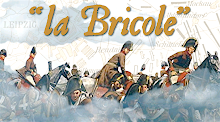This year's work on the Russians has been very productive. However, these have been my Russians of 1943-44! We have been gaming using the WW2 Blitzkrieg Commander rules, and have been thoroughly enjoying them. So naturally a lot of my hobby efforts have been focused on getting my Soviet hordes out on the table.
But this coming week our club has its first game of Napoleonics using Warlord Games' Black Powder rules. If all goes well, then Napoleonics may hopefully be a regular item on the club menu.
The first game will see the French taking on the British in the Peninsula, with His Britannic Majesty being given artillery support in the form of a section of Russian Horse Artillery. My first painted Russian unit, I'm pleased to report.
Here they are, a stone's throw from being finished. Since this photo was taken, I painted the gun barrel and have completed the brass work on the helmets and equipment. The only thing remaining to do on the gun crew is to paint the metal scabbard fittings and to highlight the helmet crests.
I've just varnished the Litko base on both sides to reduce the chance of warping. Tomorrow I'll give the figures a coat of varnish too. Once dry, I'll glue gun and miniatures to the base and texture it. After the putty and sand on the base has dried out, I'll then paint the base.
When all is done, I'll post a picture of the completed stand- hopefully in better light so that the colours come out close to what they really look like.
My photography sucks, and I always have trouble with reds, blues, and greens. The colours seen in the photo above are quite unlike how they appear in reality. Despite my best efforts at tweaking things around on iPhoto, reds always come out looking far too pinkish, and greens comes out much brighter then they actually are.
Back to the infantry, I have been dithering around with the minis I want to send to Roger to paint. Partly as a result of procrastination and of taking my own sweet time over the hated task of prepping the miniatures- removing flash and mould lines (ugh!), but also because as I mentioned much my limited hobby time has been spent on building up my WW2 collection for club games.
There was another hold up as for a while I was having second thoughts about unit sizes. The other guys have been going for 20-24 figure units and for a while I was wondering if I should conform, if for no other reason it would speed up painting time.
Being the selfish bugger that I am, though, I decided in the end that I'm going to stick with for the 28 to 36 figure units using my favoured 1:20 ratio of men to minis a la Peter Gilder. I like the look, my French have been organized that way, and I'm not about to change now. And I'm certainly not about to re-base those I've got done already!
Fortunately many rule sets- including Black Powder- accept the fact that few gamers are about to re-base their entire collections, and can accommodate different unit sizes.
As I mentioned before, the following is being shipped off to the UK to come under Roger's loving brushwork.
Tern's Brigade:
- 1st Batt. Kourinski Regt.
- 3rd Batt. Kourinski Regt.
- 1st Batt. Kolyvanskoi Regt.
- 1st Batt. 12th Jager Regt.
Here they are "in the raw", organized on their bases.
The Russian infantry were pretty uniformly dressed in 1813, even more so than the French who would take liberties with musicians and the like when they could get away with it (which was often!). With a Russian army, there are much fewer options, but there remain a number of ways to make Russian infantry battalions look different from one another so that it is easy to tell stands apart in the game, other than just the standard regimental distinctions in shoulder straps and in the colours of flag staffs and drumsticks.
I decided to have the two battalions of the Kourinski in greatcoats and mixed headgear, but one will be advancing and the other will be in march attack poses. Kolyvanskoi will also be in march attack, but is wearing a mix of greatcoats and tunics, and all will wear the kiwer. The 12th Jagers will be advancing in a mix of headgear, but no greatcoats. Still with me?
Even in summer many men preferred to wear the greatcoat, as it was looser and more comfortable than the tunic which they would simply roll up and put in their backpacks. My Russians will be modelled as they were in autumn at the beginning of the Leipzig campaign, so anything goes!
I will work myself on the Vitebski and Koslovski regiments which are already on my workbench, along with two more battalions of Jagers. So if all goes well, I'm anticipating that by the end of the year, I should be able to field the entire 15th Division under General Kornilov.
As I'm sure you will agree, Roger is an excellent painter and you can see his work here. Drool fuel. I have to say I'm really looking forward to having a collection I in which I can take a lot of pride.





































